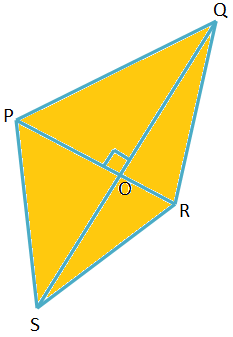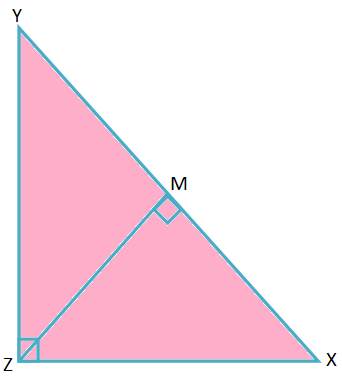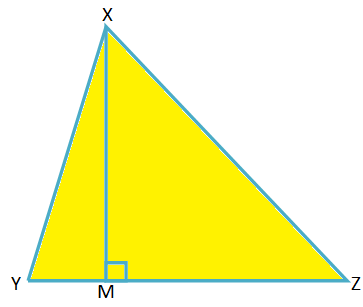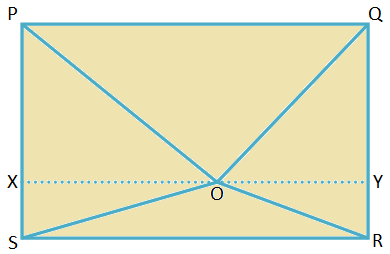Riders Based on Pythagoras’ Theorem
Here we will solve different types of examples on establishing riders based on Pythagoras’ theorem.
1. In the quadrilateral PQRS the diagonals PR and QS intersects at a right angle. Prove that PQ2+ RS2 = PS2 + QR2.
Solution:
Let the diagonals intersect at O, the angle of intersection being a right angle.
In the right-angle ∆POQ, PQ2 = OP2 + OQ2.
In the right-angle ∆ROS, RS2 = OR2 + OS2.
Therefore, PQ2 + RS2 = OP2 + OQ2 + OR2 + OS2 ................. (i)
In the right-angle ∆POS, PS2 = OP2 + OS2.
In the right-angle ∆QOR, QR2 = OQ2 + OR2.
Therefore, PS2 + QR2 = OP2 + OS2 + OQ2 + OR2 ................. (ii)
From (i) and (ii), PQ2+ RS2 = PS2 + QR2. (Proved).
2. In ∆XYZ, ∠Z = 90° and ZM ⊥ XY, where M is the foot of the perpendicular. Prove that 1ZM2 = 1YZ2 + 1XZ2.
Solution:
In ∆XYZ and ∆ZYM,
∠XZY = ∠ZMY = 90°,
∠XYZ = ∠ZYM (Common Angle)
Therefore, by AA criterion of similarity, ∆XYZ ∼ ∆ZYM.
XYYZ = XZZM
⟹ YZ ∙ XZ = XY ∙ ZM
Therefore, ZM = YZ∙XZXY
Therefore, 1ZM2 = XY2YZ2∙XZ2 = XZ2+YZ2YZ2∙XZ2; [By Pythagoras’ theorem)
Therefore, 1ZM2 = 1YZ2 + 1XZ2. (Proved)
3. In ∆XYZ, ∠Z is acute and XM ⊥ YZ, M being the foot of the perpendicular. Prove that 2YZ ∙ ZM = YZ2 + ZX2 - XY2.
Solution:
From the right-angled ∆XMY,
XY2 = XM2 + YM2
= XM2 + (YZ - ZM)2
= XM2 + YZ2 + ZM2 - 2YZ ∙ ZM (from algebra)
= YZ2 - 2YZ ∙ ZM + (XM2 + ZM2)
= YZ2 - 2YZ ∙ ZM + XZ2 (from right-angled ∆XMZ)
Therefore, 2YZ ∙ ZM = YZ2 + ZX2 – XY2. (Proved)
4. Let PQRS be a rectangle. O is a point inside the rectangle. Prove that OP2 + OR2 = OQ2 + OS2.
Solution:
PQRS is a rectangle for which PQ = SR = length and QR = PS = breadth.
Join OP, OQ, OR and OS.
Draw XY through O, parallel to PQ.
As ∠QPS and ∠RSP are right angles, ∆PXO, ∆SXO, ∆RYO and ∆QYO are right-angled triangles.
Therefore, by Pythagoras’ theorem,
OP2 = PX2 + OX2,
OR2 = RY2 + OY2,
OQ2 = QY2 + OY2 and
OS2 = SX2 + OX2
Therefore, OP2 + OR2 = PX2 + OX2 + RY2 + OY2 ......... (i)
OQ2 + OS2 = QY2 + OY2 + SX2 + OX2 ......... (ii)
But in the rectangle XSRY, SX = RY = breadth
and in the rectangle PXYQ, PX = QY = breadth.
Therefore, from (i) and (ii), OP2 + OR2 = OQ2 + OS2.
From Riders Based on Pythagoras’ Theorem to HOME PAGE
Didn't find what you were looking for? Or want to know more information about Math Only Math. Use this Google Search to find what you need.
Recent Articles
-
Vertical Subtraction | Examples | Word Problems| Video |Column Method
Mar 22, 25 05:20 PM
Vertical subtraction of 1-digit number are done by arranging the numbers column wise i.e., one number under the other number. How to subtract 1-digit number vertically? -
Worksheet on 11 Times Table | Printable Multiplication Table | Video
Mar 22, 25 05:08 PM
Worksheet on 11 times table can be printed out. Homeschoolers can also use these multiplication table sheets to practice at home. -
Worksheet on 10 Times Table | Printable Multiplication Table | Video
Mar 21, 25 03:46 PM
Worksheet on 10 times table can be printed out. Homeschoolers can also use these multiplication table sheets to practice at home. -
5th Grade Prime and Composite Numbers | Definitions | Examples | Math
Mar 21, 25 12:18 AM
5th grade prime and composite numbers -
14 Times Table | Read and Write Multiplication Table of 14| Video
Mar 20, 25 04:03 PM
In 14 times table we will learn how to read and write multiplication table of 14. We read fourteen times table as:One time fourteen is 14 Two times fourteen are 28 Three times fourteen are 42









New! Comments
Have your say about what you just read! Leave me a comment in the box below. Ask a Question or Answer a Question.